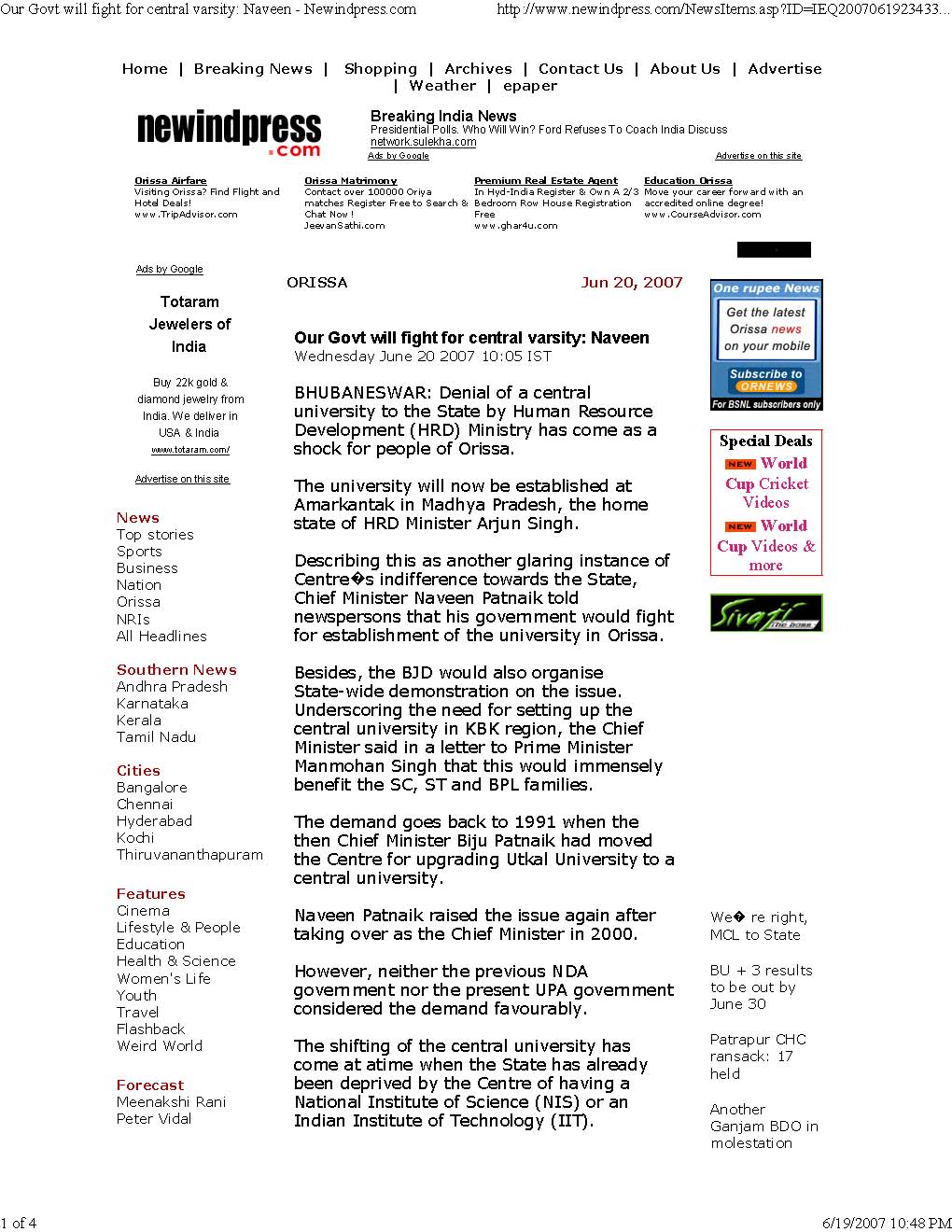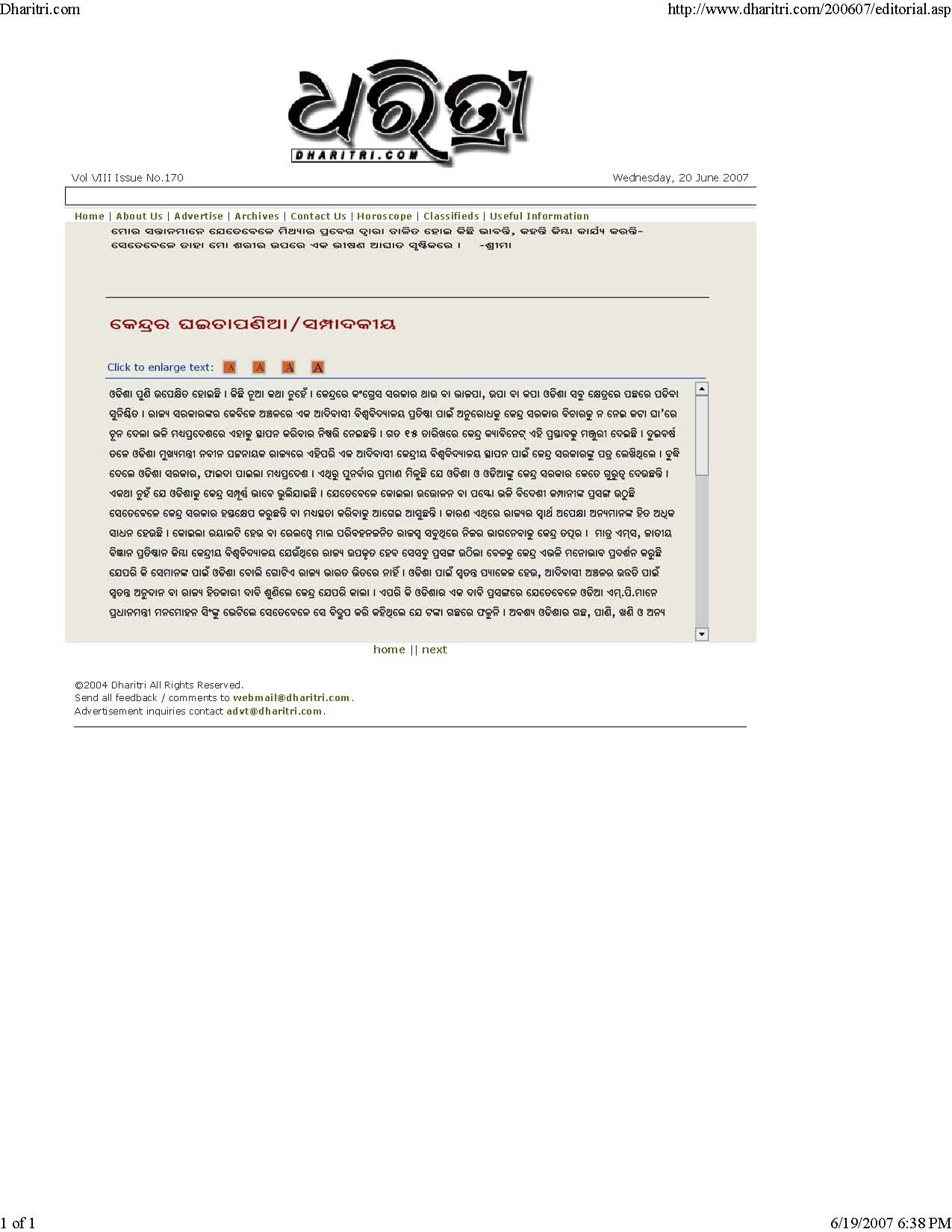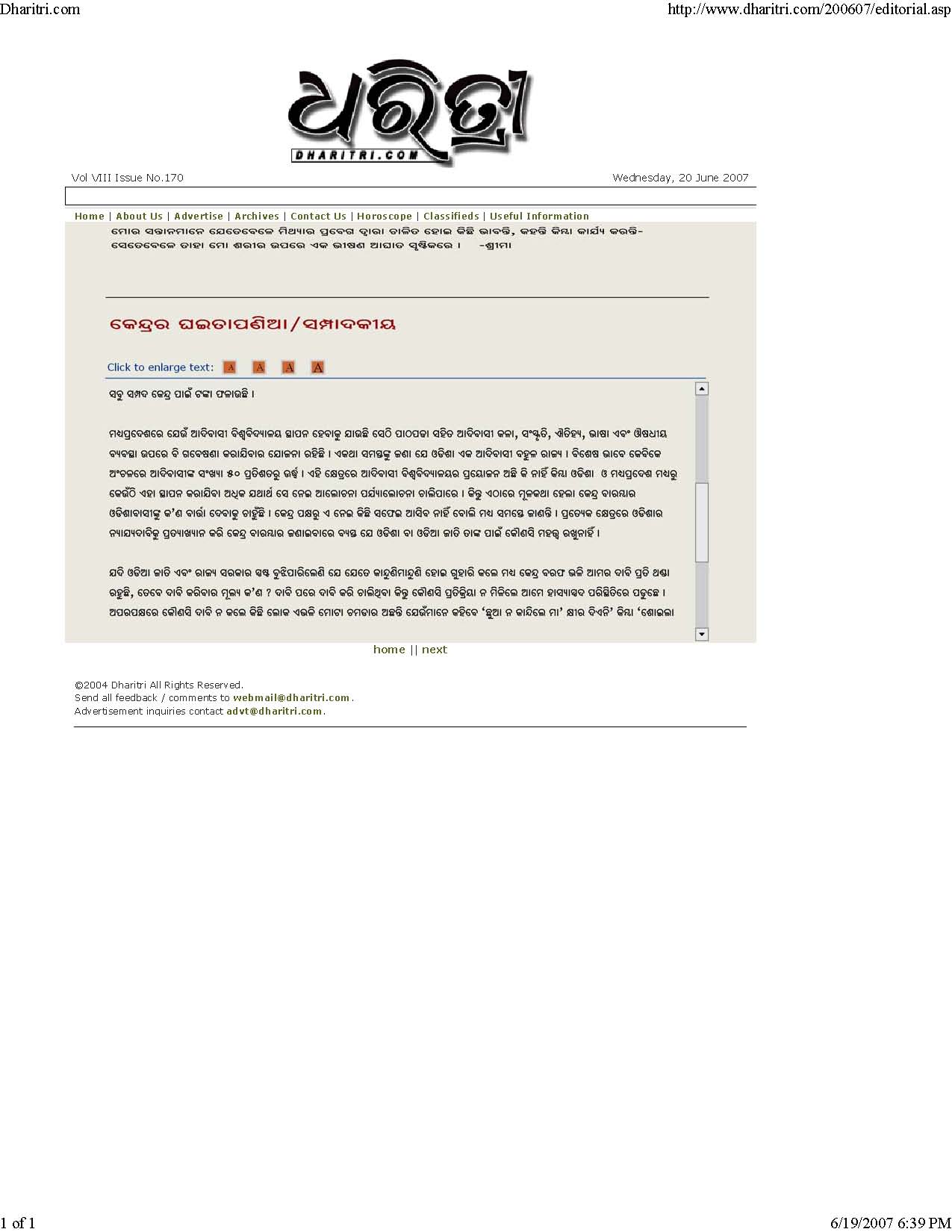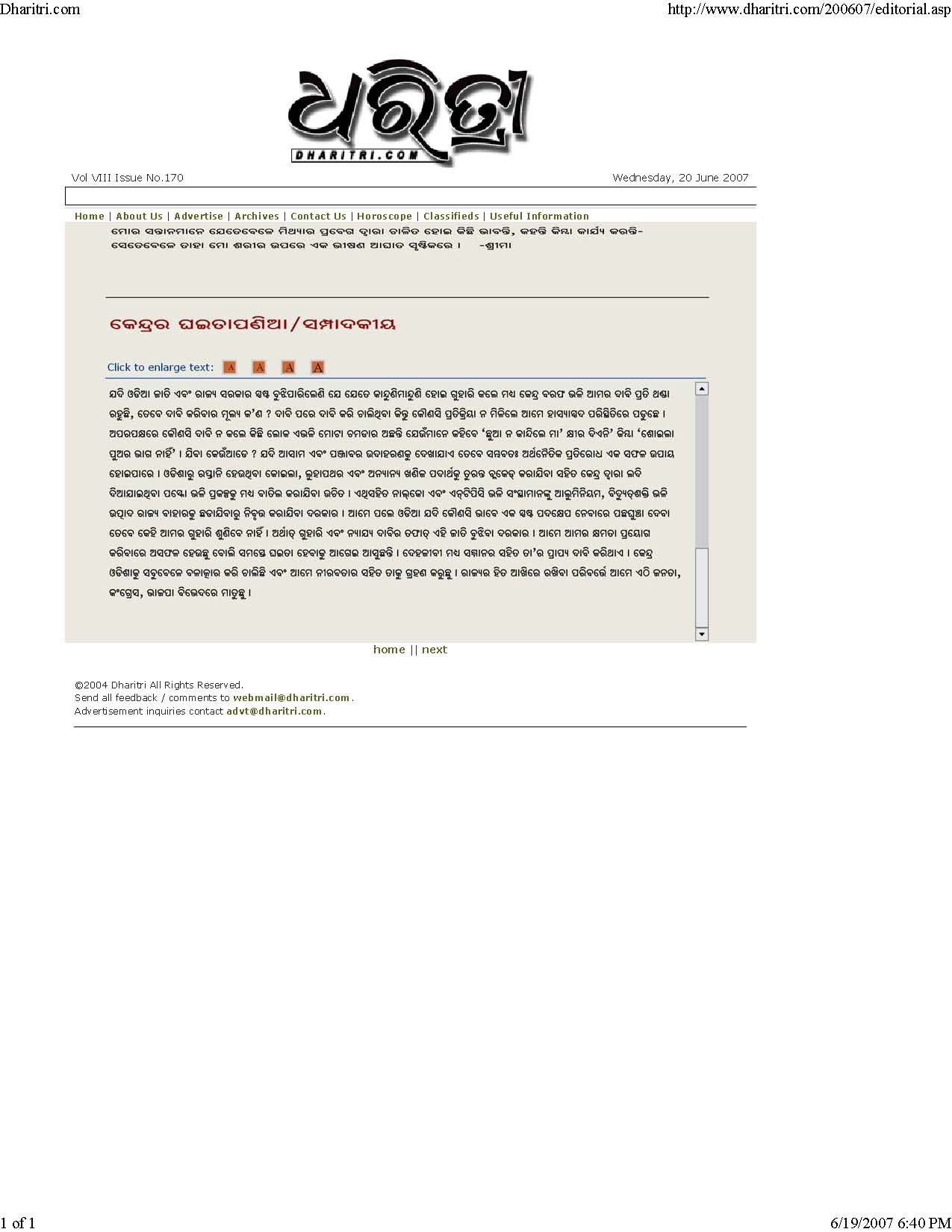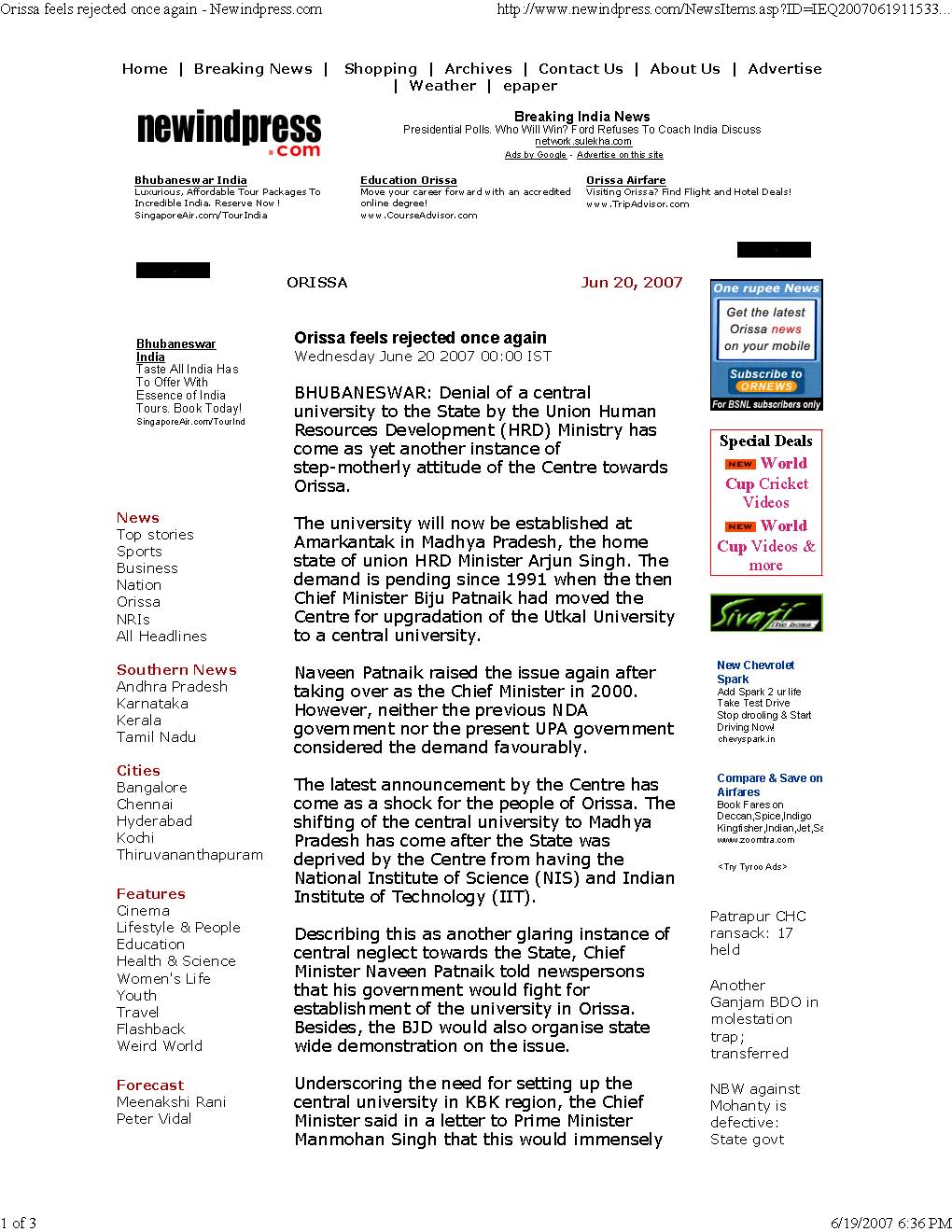India can not progress much if it leaves behind big parts of its population and areas; same is true for Orissa. Unfortunately the most backward areas of India also happen to be in Orissa. We must make sure that these areas are given adequate attention by all governments.
1. Some statistical points on KBK, the most backward districts in Orissa as well as India; on Orissa and on MHRD spending in Orissa.
(a) Population below the poverty line in southern Orissa (of which KBK is a part) is reported to be 89.17% of the people according to the 1999-2000 NSS data and 72% of the families according to the 1997 census.
(b) The literacy rates in the KBK districts are abysmally low. Malkangiri 31.26%, Nabarangpur 34.26%, Rayagada 35.61%, Koraput 36.2%, Nuapada 42.29%, Kalahandi 46.2%, Balangir 54.93%, Sonepur 64.07%. Two adjacent districts also have low literacy: Gajapati 41.73% and Kandhamala 52.95%. The state average is 63.1%.
(c) The tribal population percentage of the KBK districts are as follows: Malkangiri 58.36% (+19.96% SC), Rayagada 56.04% (+14.28% SC), Nabarangpur 55.27% (+15.09% SC), Koraput 50.67% (+13.41% SC), Nuapada 35.95% (+13.09% SC), Kalahandi 28.88% (+17.01% SC), Sonepur 22.11% (+9.5% SC), Balangir 22.06% (+15.39% SC). Two adjacent districts also have high tribal population. They are Kandhamala 51.51% (+18.21% SC) and Gajapati 47.88% (+8.77% SC)
(d) KBK needs sons of the soil, (highly) educated in the soil teachers, doctors, engineers, officers etc. to help in bringing KBK to the main stream of Orissa and India. With a high tribal population, it is important that they have higher education opportunities right where they live as often they do not venture out to Delhi, Hyderabad, Allahabad or Benaras to take advantage of the ST seats in the high quality central universities there and the ones that venture out do not usually return home. In this regard one must note that in the US a major percentage of Blacks, Hispanics and Native Americans who have a higher education degree have it from colleges and universities (such as HBCUs — Historically Black Colleges and Universities) near their home rather than in far flung universities.
(e) Central government spending in fully centrally funded higher education institutions in Orissa is towards the bottom among all states in India. A rough calculation in http://www.baral.us/hrd-nh.htm showed that while the central government spent (in 2005-06) per person Rs 4.07 on fully-funded-by-center HRD institution in Orissa, it spent Rs 177.12 in Delhi, Rs 105.42 in Uttaranchal, Rs 105 in Arunachal Pradesh, Rs 77.7 in Assam, Rs 33.78 in Himachal Pradesh, Rs 28.10 in West Bengal, Rs 25.12 in Karnataka, Rs 17.79 in Tamil Nadu, Rs 17.09 in Maharastra, Rs 17.08 in UP, Rs 16.2 in Jharkhand, Rs 16.05 in Andhra, Rs 14.5 in J & K, Rs 13.38 in Punjab, Rs 8.52 in Haryana, Rs 7.9 in Kerala, Rs 7.39 in Chhattisgarh, Rs 7.2 in MP, Rs 4.87 in Gujurat, Rs 2.59 in Rajasthan, and Rs 1.87 in Bihar. Now that an IIT and IIM has been announced for Bihar and an IIT has been announced for Rajasthan, Orissa will be at the bottom.
(f) As per the NSSO study of 2004-2005 Orissa is at the bottom of most higher education parameters. For example, Table 3.14.1 shows that in the 15-19 age group 29% people in Orissa are attending school/college and in the 20-24 age group this number for Orissa is 6.1%. (Both numbers are lowest among all but the small states/UTs of Dadra and Nagar Haveli, Daman & Diu and Lakshadweep.) For the Scheduled Tribe population
these numbers are 17.1% for the 15-19 age group and 4.1% for the 20-24 age group.
2. Orissa government and people have made sincere efforts towards establishing a KBK central university.
(a) Oct 24 2005: The CM meets the HRD minister Mr. Arjun Singh and proposes the idea of a KBK Central University and Mr. Singh appreciates the idea. Following is an excerpt of a press release that discusses it.
- … In addition to this, Shri Patnaik also requested for establishment of a Central University for the KBK Region, which is one of the most backward regions in the country. He pointed out that there was a heavy concentration of the scheduled tribe and scheduled caste population in this region, which has a literacy rate below 50%. Shri Patnaik stated that setting up a Central University in the KBK region would go a long way in encouraging higher education among tribal population. He added that the university could also set up specialized centres for tribal development related studies, as tribal development was one of the biggest challenges facing the country today. Shri. Arjun Singh appreciated the rationale of having a Central University in the KBK region and sought a formal proposal in this regard from the State Government. He assured that this would receive high priority whenever the Central Government considers setting up of new central universities
(b) Since then the Orissa government and the representatives of Orissa have brought up this issue many many times.
(c) A detailed proposal was sent by the Orissa government as well as by us.
(d) Here is our proposal. (word, pdf) This document has lots of detailed statistics in case you may want to use some of it in your letter.
(e) Hundred of us also sent letters about it to the PM, planning commission, etc. (word) This letter also has lots of detailed statistics in case you may want to use some of it in your letter.
3. A shock to Orissa:
(a) The Hindu first reported on the plan for the tribal university in Madhya Pradesh. Following is an excerpt from it. One may compare this excerpt with the Orissa government press release on Oct 24 2005 and it becomes clear that the idea proposed by our CM was stolen.
- … The Indira Gandhi National Tribal University will encourage studies on tribal art, culture and traditions, forests and natural resources. Tribal students will be given priority in admission. … The D. Swaminadhan Committee, set up by the University Grants Commission, recommended the setting up of a varsity exclusively for promoting tribal culture and providing tribals access to higher education.
(b) The recent PIB says the following:
The Union Cabinet today gave its approval for establishment of Indira Gandhi National Tribal University in Amarkantak, Madhya Pradesh with Central Government funding. It also approved introduction of the Indira Gandhi National Tribal University Bill, 2007 in the Parliament.
(c) http://www.ranchiexpress.com/news/n22062007.htm mentions: Jharkhand will soon house the Eastern India branch of national tribal university , chirstened Indira Gandhi National Tribal University (IGNTU). The committee of University Grant Commission (UGC) that has been asked to set up the IGNTU is looking for about 1,000 acres of land in Jharkhand for the purpose. The varsity, which will have its headquarters at Amarkantak in Madhya Pradesh, will offer array of courses to students from across the country. Dr Ram Dayal Munda, a member of the UGC committee, has been asked to look for land in Jharkhand, possibly in or around the State Capital. "The chairperson of the committee, Jose Verghese, has asked me to find a suitable piece of land here to house the IGNTU branch," Dr Munda told mediapersons.
There is no mention of KBK Central University above; nor about branches of IGNTU in Orissa. This came as a shock to people of Orissa.
4. Soothing words from the PM and the central minister from Orissa, Mr. Chandrasekhar Sahu
(a) In http://pib.nic.in/release/release.asp?relid=28780 the PM says
Today, I am happy to announce that we intend to establish 30 new Central Universities across the country. The work on the modalities for setting these up has begun and the Ministry of Human resource Development, the University Grants Commission and the Planning Commission are working to operationalize this in the next 2-3 months.
(b) Business Standard reported central minister Chandrasekhar Sahu saying:
While the first Central University is likely to be set up in Koraput,
5. In light of the above we have the following five point demand:
I. The central university in Koraput should be a multi-campus one with campuses in all the major towns in KBK+ districts. I.e., the eight KBK districts and the adjacent Gajapati and Kandhamal districts. This university should be more like the universities in the north east in that it must have special quotas for tribals and KBK+ residents.
II. The PM said there will be 30 new central universities. Since there are already about 20 central universities and Orissa has none; besides the
central university in Koraput, one of the other universities in Orissa, from a different part of Orissa, must be upgraded to central university status.
III. Branches of the Indira Gandhi National Tribal University must be made in the north western districts with high tribal population, in particular
Mayurbhanj (tribal percentage 57.87%, literacy 52.43%), Sundergarh (50.74%, 65.22%), and Keonjhar (44.52%, 59.75%); and possibly in Sambalpur (35.08% , literacy 67.01%), Deogarh (33.31%, literacy 60.78%), and Jharsuguda (31.88% , literacy 71.47%).
IV. A greenfield IIT must be established in an appropriate location in Orissa to serve the backward parts of Orissa as well as to be close enough to existing infrastructure so as to be a viable world class institution.
V. Connectivity to KBK must be upgraded with (a) fasttrack implementation of the Vijaywada-Ranchi highway and (b) Finishing three important rail projects in KBK: Khurda Rd – Balangir; Naupada-Gunupur-Therubali; and LanjigarhRd-Bhawanipatna-Junagarh-Nabrangpur-Jeypore-Malkangiri with the last exetended to Bhadrachalam Rd thus creating an alternate shorter Ranchi-Hyderabad rail connection passing through the tribal and backward areas.
July 6th, 2007
Following is an excerpt from Indiaedunews on this topic.
The Union Ministry of Health and Family Welfare has recently decided to amend the Medical Council of India (MCI) Act for giving relaxation in opening more medical colleges in the country.
In this context, the Union Health and Family Welfare Minister Dr. Anbumani Ramadoss said in Srinagar that the Ministry proposed to amend the Medical Council of India (MCI) Act that would help in categorising the States into three types: North East, NRHM and general category. Dr. Ramadoss said this in a review meeting for the implementation of National Rural Health Mission (NRHM) in Jammu & Kashmir.
As per the amendment the District Hospitals in the NRHM States with more than 250 beds would be allowed to be upgraded to the status of medical colleges. Nursing colleges and training institutions for paramedical staff could also be attached to the district hospitals.
As per the document from the NRHM site Orissa is among the 18 NRHM states. (The others are Arunachal Pradesh, Assam, Bihar, Chhatisgarh, Himachal Pradesh, Jharkhand, J & K, Manipur, Mizoram, Meghalaya, MP, Nagaland, Rajasthan, Sikkim, Tripura, UP, and Uttaranchal.)
In this regard one must note that the current requirement for a medical college with 50 seats is 400 beds (see page 13), 100 seats is 500 beds, and 150 seats is 750 ; although one can apply when one has 300 beds and one makes a deposit for the remaining number of beds.
July 6th, 2007
Business Standard reports that central minister Chandrasekhar Sahu is pursuing with the central government regarding establishing three marquee institutions in South Orissa. Following is an excerpt of that:
While the first Central University is likely to be set up in Koraput, plans for an Indian Institute of Information Technology (IIIT) and National Institute of Design (NID) in Berhampur are in the works. …
Sahu also said he has discussed the possibility of a National Institute of Design (NID) and National Institute of Fashion Technology (NIFT) being set up in Berhampur and Bhubaneswar. The recent discussions with the Union minister for commerce, Kamal Nath, and the minister for textiles, Shankarsingh Veghela, “were very positive and they assured us that they are willing to establish these institutes if the state government extended its cooperation,†said Sahu. …
While the Central University and IIIT are under the Ministry of Human Resources Development, the NID is under the Ministry of Commerce. NIFT and NIHT come under the Ministry of Textiles.
Lets analyze this. First of all if all these materializes then its great. However lets compare what Orissa will be getting vis-a-vis the other states.
- In the Central University front, the central university in Koraput should be a distributed kind like the proposed Indira Gandhi National Tribal University. It should be designed such that it has branches in all KBK+ districts from the start.
- The tribal population percentage of the KBK districts are as follows: 8 KBK districts total 38.72% (+ 16.63 % SC). Malkangiri 58.36% (+19.96% SC), Rayagada 56.04% (+14.28% SC), Nabarangpur 55.27% (+15.09% SC), Koraput 50.67% (+13.41% SC), Nuapada 35.95% (+13.09% SC), Kalahandi 28.88% (+17.01% SC), Sonepur 22.11% (+9.5% SC), Balangir 22.06% (+15.39% SC). Two adjacent districts also have high tribal population. They are Kandhamala 51.51% (+18.21% SC) and Gajapati 47.88% (+8.77% SC).
- The literacy rates in the KBK districts are as follows: Overall in 8 KBK districts 36.58% with the female literacy at 24.72%. Malkangiri 31.26%, Nabarangpur 34.26%, Rayagada 35.61%, Koraput 36.2%, Nuapada 42.29%, Kalahandi 46.2%, Balangir 54.93%, Sonepur 64.07%. Two adjacent districts also have low literacy: Gajapati 41.73% and Kandhamala 52.95%. The state average is 63.1%.
- India already has 20 central universities and if 30 more are going to be made then besides the central university in Koraput one of the other universities in Orissa should also be upgraded to a central university.
- There will be 19 new IIITs. Orissa will be getting one of them. This is good but does not take Orissa out of the bottom of MHRD spending
- NID is good. But it does not replace the IIT that was taken away from Orissa. The 2007-08 budget for the 7 IITs is a total of 1553.70 cores (i.e., an average of 221.96 crores) while the 2007-08 budget for NID is 20.25 crores.
- Hence, Orissa must: (a) continue to push for an IIT in Orissa; (b) push for the Central University in Koraput to have branches in the KBK+ districts from the very beginning; (c) this central university should have special quote for tribals and locals as is the case in many north eastern states and as will be the case in the Indira Gandhi national tribal university; (d) push for one of the other universities in Orissa to be upgraded to a central university; (e) Make sure branches of the Indira Gandhi National Tribal University exist in the north western districts with high tribal population, in particular Mayurbhanj (tribal percentage 57.87%, literacy 52.43%), Sundergarh (50.74%, 65.22%), and Keonjhar (44.52%, 59.75%); and possibly in Sambalpur (35.08% , literacy 67.01%), Deogarh (33.31%, literacy 60.78%), and Jharsuguda (31.88% , literacy 71.47%).
June 25th, 2007
Dear Mr. Ramesh:
I read about your visit to Bhubaneswar and some news reports and quotes of yours in Statesman. (See article below.)
1. One of them says:
“I do not want to score political points but what if I ask what were these people doing in all the six years that the NDA was in power. The IIT could have come up in six years time , what were you (the BJD) doing when all that you needed was to take up the file to Mr Vajpayee and he would have signed it,” shot back Mr Ramesh.
2. Another paragraph of that report says:
Repeatedly emphasising that he was one with the demand of the state for institutes of higher education, Mr Ramesh said at the same time, one should realise that an IIT will solve the problem of unemployment. Has Kanpur IIT contributed in any way to Kanpur? In fact, IITs have contributed more to the US economy than Indian economy, he remarked.
===
Mr. Ramesh: I don’t know if your intent was to score political points or if this is your thinking. You are quoted as saying that “you do not want to score political points”, so these must be your real views.
(1′) Your comment (1) implies that a state can get an IIT (or similar institute) only when its coalition is in power in Delhi. Do you really mean that? So is the UPA government in Delhi only for states with UPA friendly governments and the rest should go to hell in regards to higher education institutions? Not only that you seem to be implying that it is not right (timing) for Orissa to ask for an IIT now because the ruling party of the state is not aligned with the center.
Continue Reading June 21st, 2007
Dear Readers:
I hope many of you are enraged and disgusted by this repeated injustice meted out to Orissa by the MHRD; especially now it seems that the MHRD has orchestrated hijacking of a good, sensible and extremely relevant idea proposed by our chief minister: the idea of tribal central university in the KBK region with the goal of catering to the 50% tribal population in that area and 38% tribal population across Orissa.
Often many have blamed the Orissa government for not taking timely initiatives or not coming up with innovative ideas, but this time it took the initiative, it suggested a great idea, followed up on it regularly, but the end result is same; the idea gets implemented in the home state of the minister of HRD Mr. Arjun Singh.
We must convey our displeasure, disgust, deep disappointment and anger to the central government. Please fax a letter to the PMO (fax numbers: 011-2301-8668, 2301-5470, 2301-5603, 2301-8939 ) and also fax a copy of that letter to the CMO (0674-2400100 ) and Mr. Chandrasekhar Sahu (011-23061695), the sole central minister from Orissa. After that we must follow-up with the CMO (cmo@ori.nic.in) by email and Mr. Sahu by phone (Personal Secy: 09868501233 off: 011-23792469, 23792470) and tell them to take our faxes and meet the PM and the national press with all our faxes and do a dharana until the two immediate injustices of moving an IIT in Orissa after it was announced and stealing the idea of a tribal university proposed for the KBK area are corrected. Following are some pointers and points which may help in writing your letter. I am making it short so that its easier for you to draft the letter.
Continue Reading June 18th, 2007
The PIB says the following:
The Union Cabinet today gave its approval for establishment of Indira Gandhi National Tribal University in Amarkantak, Madhya Pradesh with Central Government funding. It also approved introduction of the Indira Gandhi National Tribal University Bill, 2007 in the Parliament.
This would ensure establishment of a teaching and affiliating University for facilitating and promoting avenues of higher education and research facilities for the tribal population of the country.
The objects of the University include inter-alia, promoting studies and research in tribal art, culture, tradition, language, custom, medicinal systems, forest based economic activities, including special studies in the flora and fauna, and advancements in technologies relating to natural resources of the tribal areas.
Apart from affiliating the colleges, the University has the power to establish such number of its own regional centers in tribal areas as the University may deem fit.
There will be at least one school in every regional Centre, to serve as a model school for the schools of the region, where from the tribal students would be expected to join the local colleges, the off-campuses or the University.
Another news item mentions the financial parameters and objectives of this university. It says:
The initial financial requirement of the proposed varsity is estimated at Rs.600 million and a recurring expenditure of Rs.120 million annually.
‘The objects of the university include inter-alia, promoting studies and research in tribal art, culture, tradition, language, custom, medicinal systems, forest based economic activities, including special studies in the flora and fauna, and advancements in technologies relating to natural resources of the tribal areas,’ Information and Broadcasting Minister P.R. Dashmunsi said after a cabinet meeting.
The Rs 600 million number sounds too low. My guess is that it is a typo and the unit should be crores instead of millions.
**
A tribal central university, or central universities in tribal areas is a good idea about which I earlier wrote in Indian Express. However, a similar idea was suggested by Orissa, couple of years back, which the HRD minister had appreciated. Following is an excerpt from the press release issued by Orissa government at that time:
… In addition to this, Shri Patnaik also requested for establishment of a Central University for the KBK Region, which is one of the most backward regions in the country. He pointed out that there was a heavy concentration of the scheduled tribe and scheduled caste population in this region, which has a literacy rate below 50%. Shri Patnaik stated that setting up a Central University in the KBK region would go a long way in encouraging higher education among tribal population. He added that the university could also set up specialized centres for tribal development related studies, as tribal development was one of the biggest challenges facing the country today. Shri. Arjun Singh appreciated the rationale of having a Central University in the KBK region and sought a formal proposal in this regard from the State Government. He assured that this would receive high priority whenever the Central Government considers setting up of new central universities.
Orissa MPs also pursued it and we had sent detail proposal on it to the planning commission and HRD ministry and the PM. I hope the HRD minister did not just steal the idea to his home state. Such opportunistic behavior by the HRD ministry would discourage states with suggesting ideas.
However, a silver line is that the PM has mentioned recently that each state will have a central university. The question is when will that happen.
Moreover, regardless of that happening, central ministers should not steal ideas proposed by states to their own state. They are supposed to look out for the whole country not steal things to their states. To do things for their state they have the MPLAD.
June 15th, 2007

